Meeting the Demanding Energy Needs of AI Servers with Advanced Technology
This blog post explores innovations in power devices, gate drivers and advanced controllers with Digital Signal Processing (DSP) capabilities to meet Artifical Intelligence (AI) servers' power and efficiency needs.
Advancing Power Efficiency for AI Servers
The rise of artificial intelligence (AI) has significantly increased computing demands, necessitating more powerful AI servers and robust, efficient power supplies. This surge in computational power correlates with higher power consumption, creating a need for greater power levels and higher watts per rack. This blog post explores innovations in power devices, gate drivers and advanced controllers with Digital Signal Processing (DSP) capabilities to meet AI servers' power and efficiency needs.
AI servers are essential for modern data centers, driving tasks like machine learning and natural language processing, but they come with high energy demands. As data centers expand AI capabilities, they face the challenge of supplying sufficient power while maintaining efficiency to manage costs and minimize environmental impact. AI workloads can double energy use compared to traditional tasks, with AI now accounting for 10-20% of total energy use in data centers. AI accelerator servers, requiring 2-4 times more power, are the primary energy consumers.
Advances in power device technology, including MOSFETs and gate drivers, have led to more efficient power conversion by reducing resistance, speeding up switching times and improving thermal performance. Server Power Supply Units (PSUs) have evolved to employ advanced wide bandgap devices like silicon-carbide MOSFETs and gallium-nitride FETs, allowing for higher switching frequencies and fewer magnetic components. Server PSUs are also shifting from traditional mechanical relays to solid-state relays, offering a smaller footprint, enhanced reliability and better high-temperature performance.
Need for Advanced Controllers With DSP Capabilities
Microcontrollers (MCUs) with integrated DSP capabilities are at the forefront of this technological evolution. These advanced MCUs manage sophisticated algorithms that optimize power management, enabling precise control over the power supply's performance. With real-time data processing capabilities, these MCUs can adjust to the fluctuating power demands of AI servers, ensuring efficient power distribution. Our dsPIC® Digital Signal Controllers (DSCs) are designed to deliver the performance needed for the demanding power conversion and control applications found in power supply units (PSUs) and power distribution units (PDUs) for AI servers and data centers.
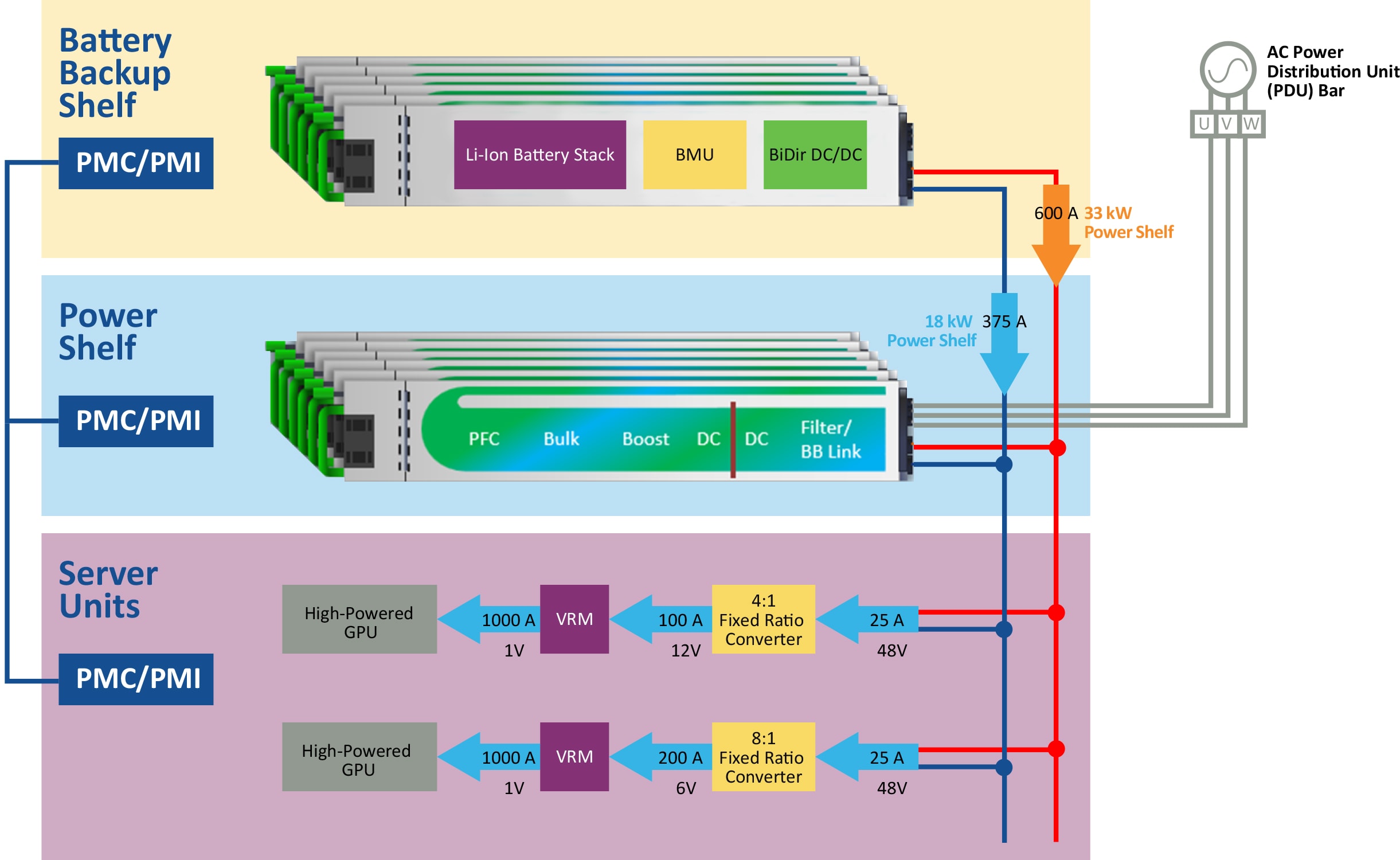 |
Figure 1. High-level schematic of the power distribution within a data server
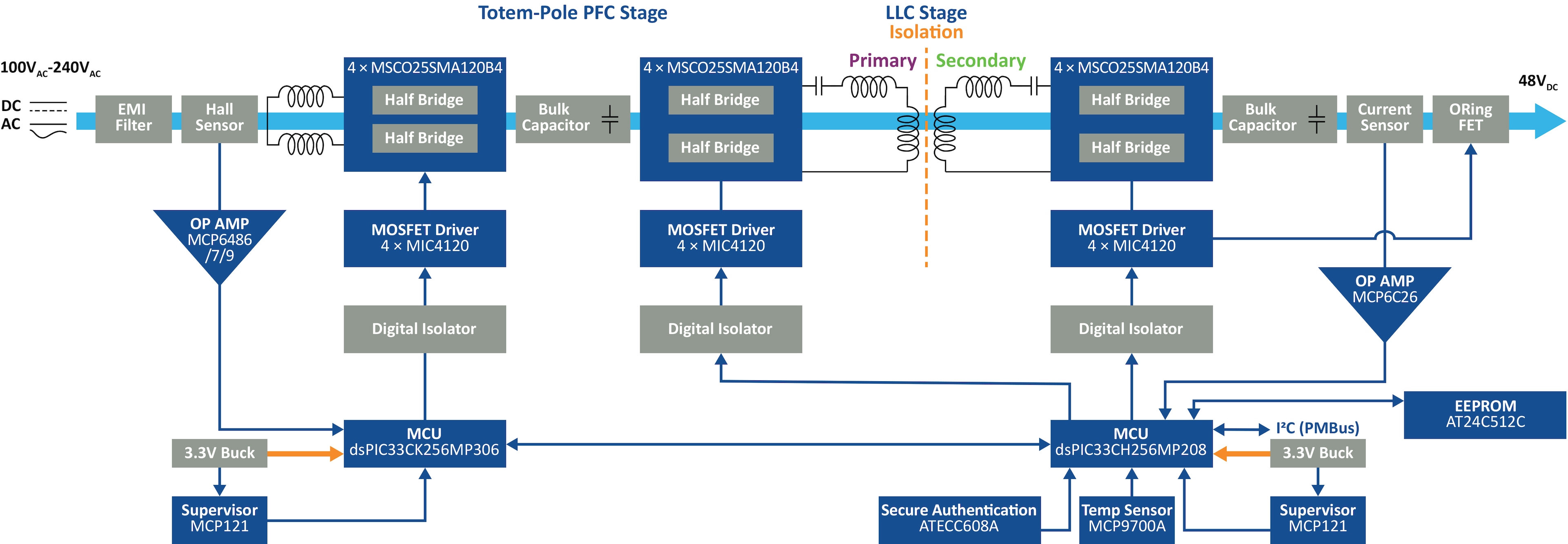 |
Figure 2. Block schematic of Power Supply Unit (PSU) in a data server
Key Features of dsPIC33 DSCs
dsPIC DSCs play a pivotal role in digital power conversion for data centers, operating up to 100MHz/core with a dual-core option and up to 200 MHz with a single-core option and advanced on-chip peripherals for intelligent power supply designs. They feature main and secondary cores for separate function designs, with the secondary core handling latency-critical algorithms and the main core managing communication and system-level functions. Configurable PWM control inputs support various power topologies, and real-time firmware upgrades are possible. For GPU power supplies, dsPIC DSC is available in 4x4mm pkg with Corner Anchor to enable Brick DC-DC qualifying for IPC-9592B spec, and peripheral integration reduces BOM and system costs. dsPIC DSCs enhance power supply efficiency through high-speed PWM, supporting sophisticated algorithms for power factor correction, resonant converters and synchronous rectification. They enable robust power monitoring, predictive maintenance and ensure data center uptime through precise measurement, advanced control algorithms, data analysis and fault management.
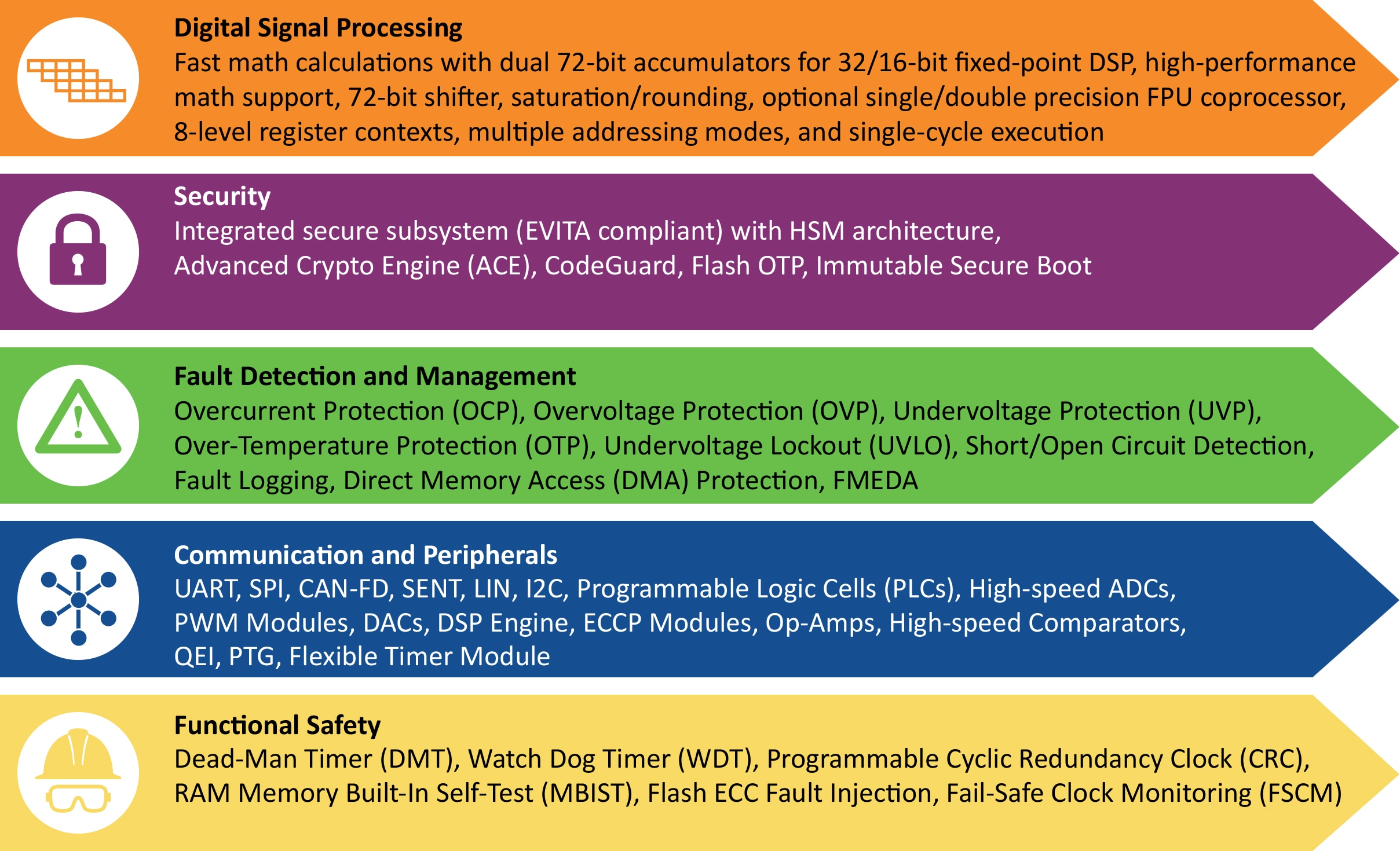 |
Figure 3. dsPIC DSC features enabling functionality and efficiency in digital power conversion
Our controllers also support various communication protocols for seamless integration and feature fast ADCs and interrupt capabilities for quick fault detection and response. dsPIC DSCs enhance energy efficiency in AI servers and data centers by providing precise power conversion control, minimizing energy waste and heat generation. They offer scalability through diverse memory sizes, pin counts and peripheral options, allowing for customized designs. We support development with software libraries and tools like MPLAB X IDE, and the high-performance DSP engine and specialized peripherals facilitate advanced digital control loops with minimal external components.
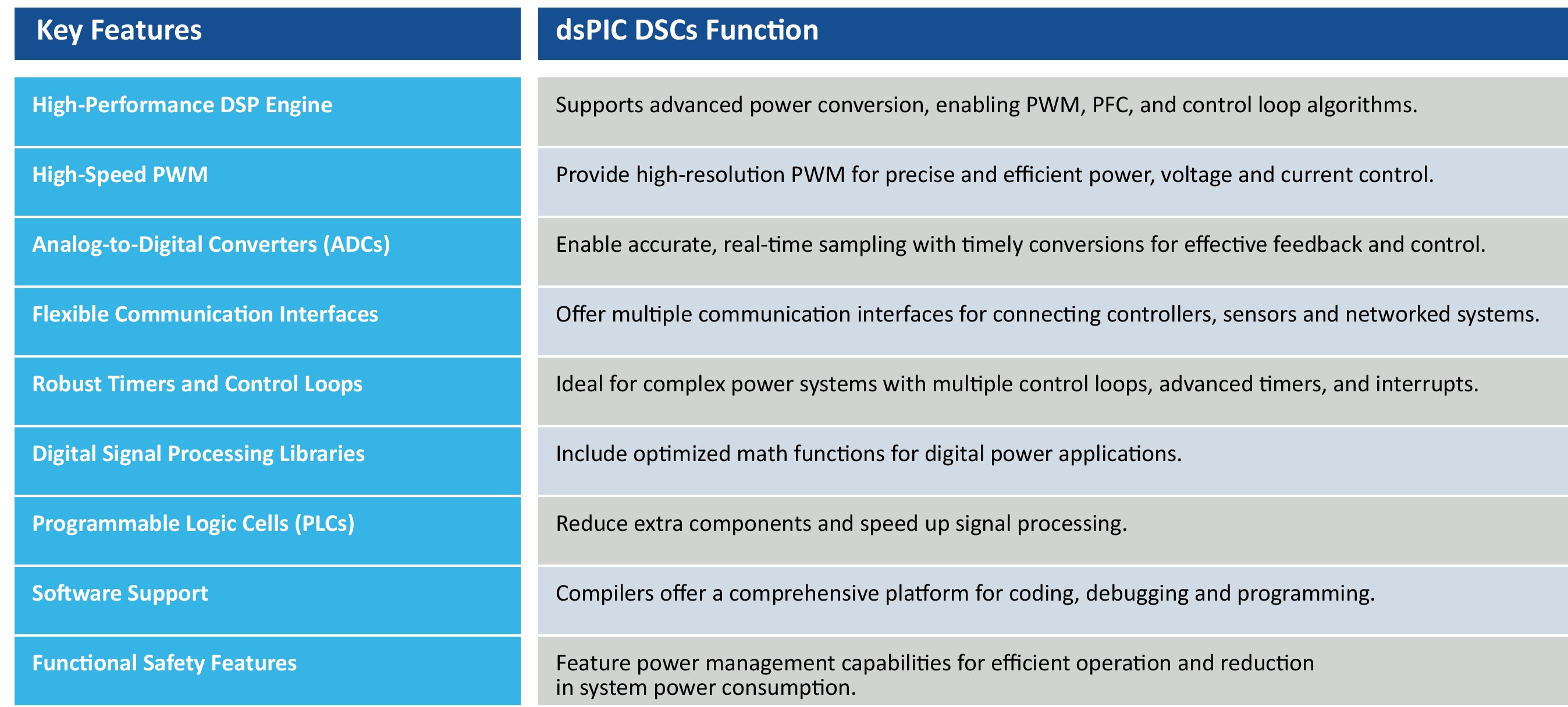 |
Figure 4. Key functions and features of dsPIC DSCs relevant to data centers
How the New dsPIC33A Core Enables Digital Power Conversion
Advanced applications, such as AI servers, require efficient power management, stringent security and functional safety measures, necessitating high-performance Digital Signal Controllers (DSCs). This demand has led to the development of units like the dsPIC33A, with enhanced CPUs operating at higher clock speeds. These DSCs process more instructions per second, enabling quicker response times and sophisticated algorithms crucial for managing power demands and improving data center efficiency. Increased processing power supports advanced control algorithms, enhancing power conversion efficiency and stability. Enhanced monitoring ensures reliability in critical applications. As security threats grow, implementing cryptographic techniques for firmware attestation and device authentication becomes vital, raising memory and performance requirements. The dsPIC33A DSC significantly impacts digital power conversion by offering superior performance, efficiency and flexibility for modern applications.
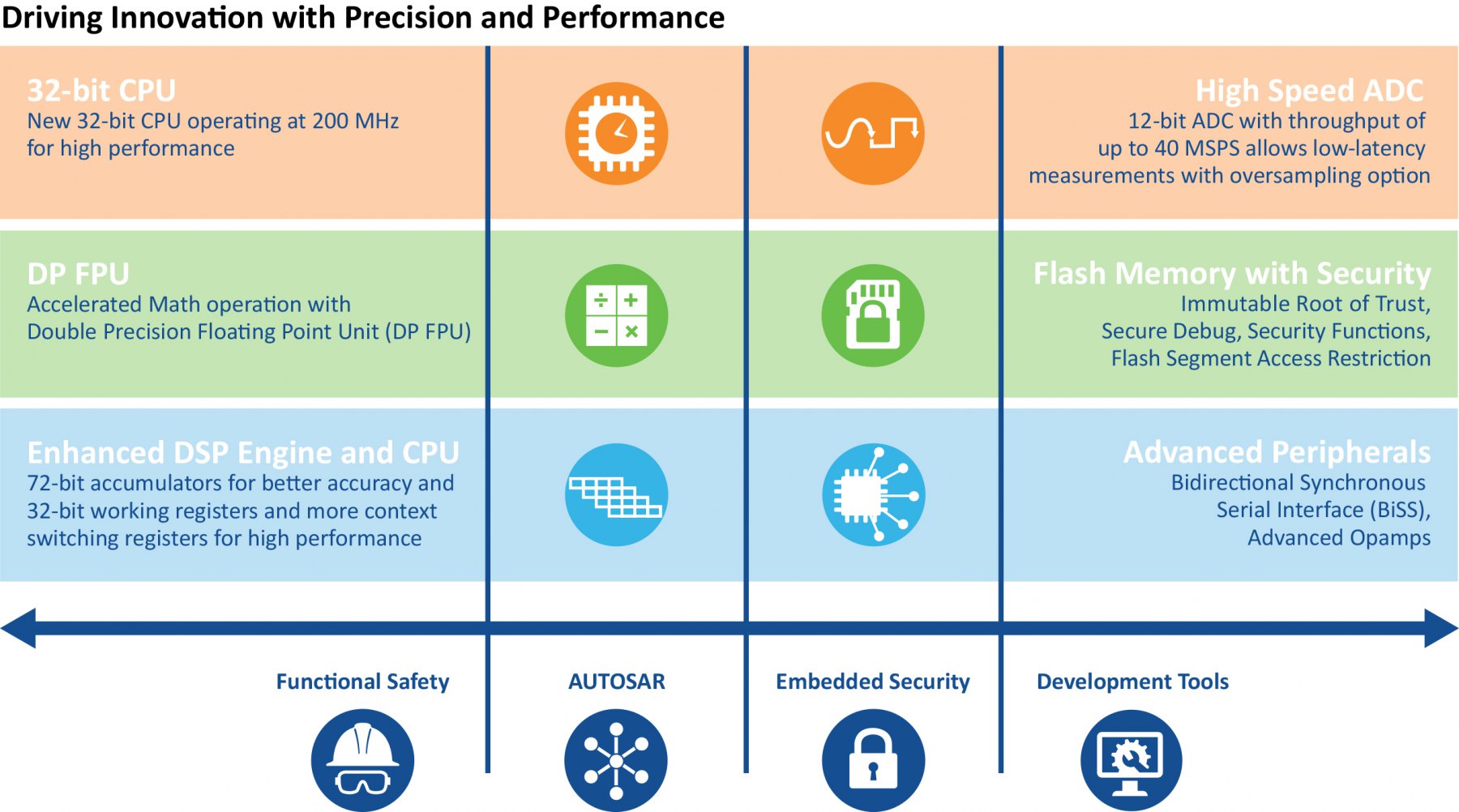 |
Figure 5. dsPIC33A new features and enhancements
Conclusion
The growing demand for AI server power presents a challenge that can be addressed with cutting-edge advancements in power technology. Utilizing high-efficiency MOSFETs, sophisticated gate drivers and dsPIC DSCs equipped with high-performance and advanced peripherals enables the development of power supplies capable of meeting the intensive energy requirements of AI servers. Digital power conversion and advanced algorithms play a crucial role in maintaining peak efficiency for these power supplies. To maintain leadership in AI server technology, it is essential for industry leaders and data center operators to invest in state-of-the-art power supply solutions. Embracing these advanced technologies ensures that AI servers not only deliver exceptional performance but also operate with optimal energy efficiency, paving the way for a more sustainable and cost-effective future in high-performance computing.
